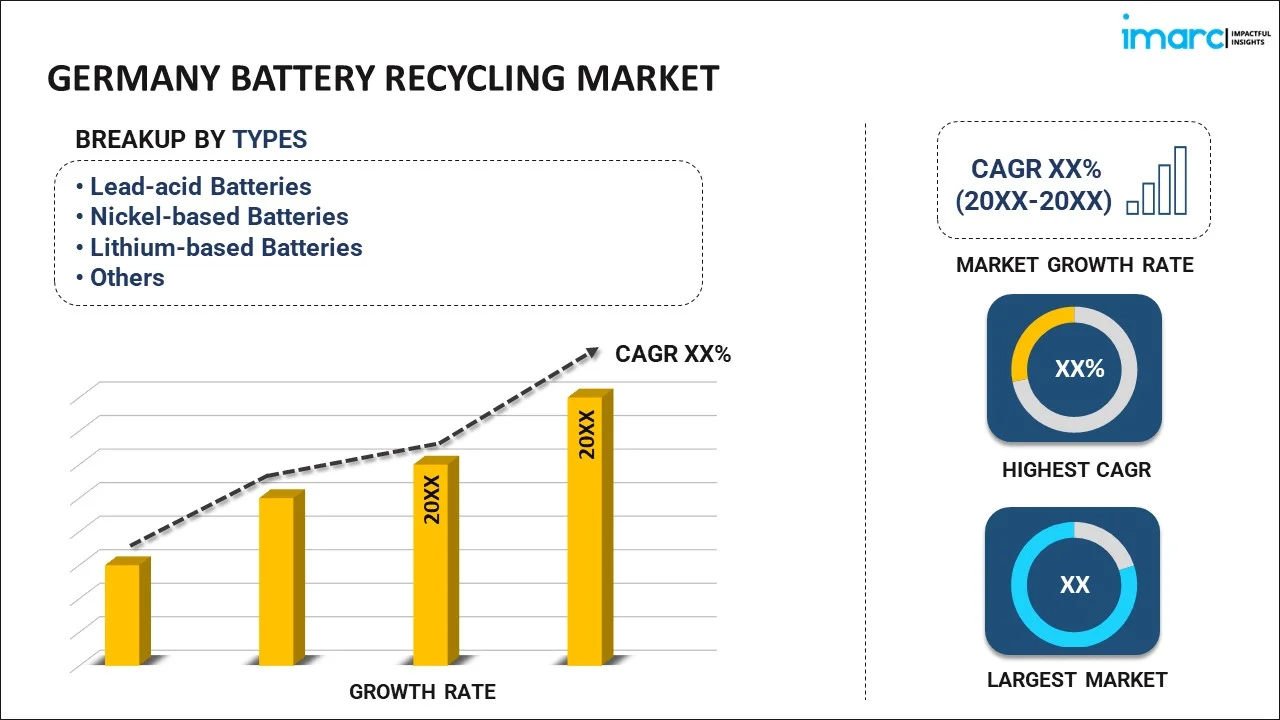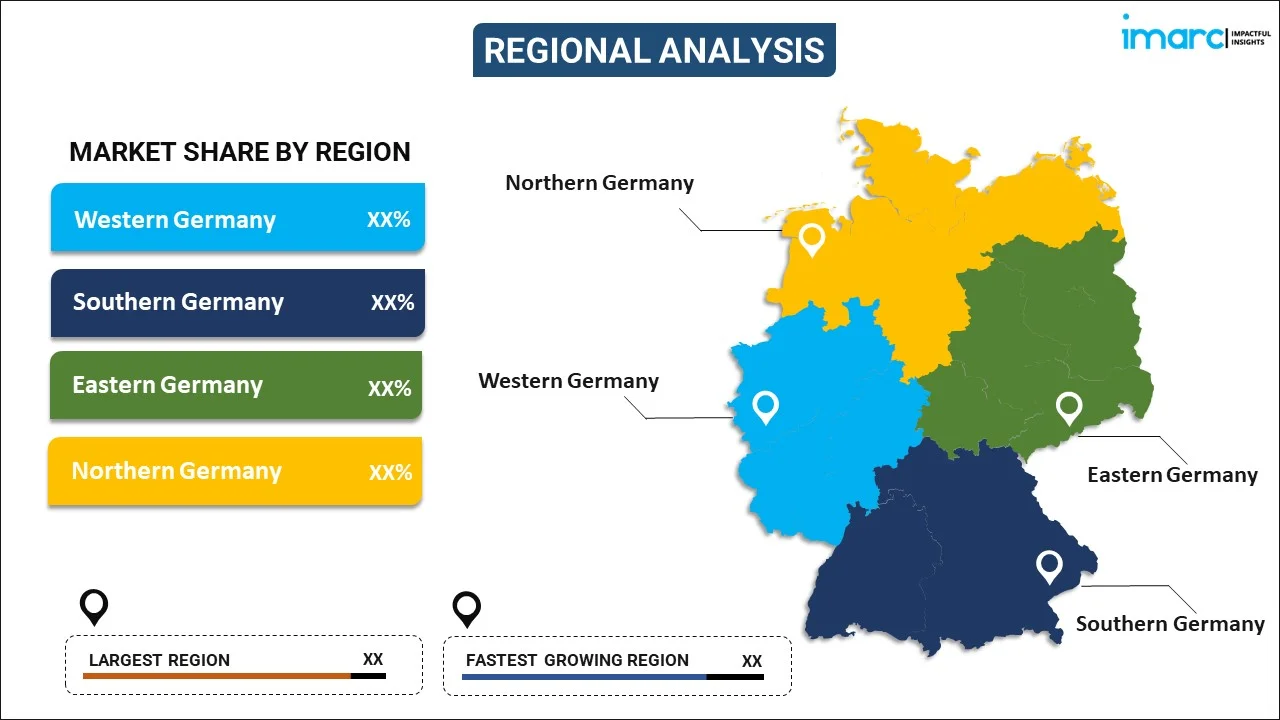
Germany Battery Recycling Market Report by Type (Lead-acid Batteries, Nickel-based Batteries, Lithium-based Batteries, and Others), Source (Industrial, Automotive, Consumer Products, Electronic Appliances, and Others), End-Use (Reuse, Repackaging, Extraction, and Others), Material (Manganese, Lithium, Nickel, Cobalt, Lead, Aluminium, and Others), and Region 2025-2033
Germany Battery Recycling Market Overview:
The Germany battery recycling market size reached USD 754.0 Million in 2024. Looking forward, IMARC Group expects the market to reach USD 1,503.2 Million by 2033, exhibiting a growth rate (CAGR) of 8% during 2025-2033. Stringent environmental regulations mandate responsible disposal, rise of electric vehicles (EVs) and renewable energy storage, technological advancements enhance recycling efficiency, growing consumer awareness regarding eco-friendly practices, government incentives, and circular economy initiatives are bolstering the market growth.
|
Report Attribute
|
Key Statistics
|
|---|---|
|
Base Year
|
2024
|
|
Forecast Years
|
2025-2033
|
|
Historical Years
|
2019-2024
|
|
Market Size in 2024
|
USD 754.0 Million |
|
Market Forecast in 2033
|
USD 1,503.2 Million |
| Market Growth Rate 2025-2033 | 8% |
Germany Battery Recycling Market Trends:
Stringent Environmental Regulations:
Germany has some of the world’s strictest environmental regulations, batteries must be disposed of responsibly and handled with recycling measures in place. For instance, in 2023, the Batteries Act came into effect as a component of German law implementing the EU Batteries Directive. Its objectives are to make sure that batteries are disposed of in an environment-friendly method and for battery manufacturers to fulfil their responsibilities as regards disposal. To this end, legislation like the EU Battery Directive defines exact targets for recycling rates and prohibits the use of certain hazardous materials in battery manufacturing. These regulations are driving the creation of an effective recycling infrastructure and processes to help avoid breaking them, which means end-of-life batteries disposal must be done in a green way.
Rise of Electric Vehicles and Renewable Energy Storage Solutions:
The rapid growth of electric vehicle (EV) and renewable energy storage solutions will lead to the growing need for battery recycling facilities across Germany. According to industry reports, Germany is one of the leading countries in Europe when it comes to electric car sales. in 2023 its sales penetration rate of EV was 37%. However, as the automotive industry continues to evolve towards electrification and renewables, it has created an overwhelming amount of these batteries that eventually reach end-of-life. It is important to develop a full circular ecosystem accommodating various types of battery chemistries and formats.
Technological Advancements:
Technological advancements play a pivotal role in enhancing the efficiency and feasibility of battery recycling processes in Germany. Continuous innovation in recycling technologies enables the extraction of valuable materials from batteries with greater precision and cost-effectiveness. Advanced sorting techniques, such as hydrometallurgical processes and pyrometallurgy, facilitate the recovery of metals like lithium, cobalt, and nickel, essential for manufacturing new batteries. Furthermore, research and development initiatives focus on improving recycling yields and minimizing environmental impact, driving the evolution of the recycling industry.
Germany Battery Recycling Market News:
- In 2023, PowerCo, the Volkswagen battery subsidiary, and Umicore, Belgian materials technology group, have launched their joint venture. The joint venture will produce precursor (pCAM) and cathode active materials (CAM). Both parent companies aim to expand Ionway’s annual production capacity to 160 GWh per year by the end of the decade, which is equivalent to the demand of about 2.2 million battery electric vehicles.
- In 2024, Duesenfeld won the German Sustainability Award 2024 for environmentally friendly recycling processing of lithium-ion batteries.
Germany Battery Recycling Market Segmentation:
IMARC Group provides an analysis of the key trends in each segment of the market, along with forecasts at the country level for 2025-2033. Our report has categorized the market based on type, source, end-use, and material.
Type Insights:

- Lead-acid Batteries
- Nickel-based Batteries
- Lithium-based Batteries
- Others
The report has provided a detailed breakup and analysis of the market based on the type. This includes lead-acid batteries, nickel-based batteries, lithium-based batteries, and others.
Source Insights:
- Industrial
- Automotive
- Consumer Products
- Electronic Appliances
- Others
A detailed breakup and analysis of the market based on the source have also been provided in the report. This includes industrial, automotive, consumer products, electronic appliances, and others.
End-Use Insights:
- Reuse
- Repackaging
- Extraction
- Others
The report has provided a detailed breakup and analysis of the market based on the end-use. This includes reuse, repackaging, extraction, and others.
Material Insights:
- Manganese
- Lithium
- Nickel
- Cobalt
- Lead
- Aluminium
- Others
A detailed breakup and analysis of the market based on the material have also been provided in the report. This includes Manganese, Lithium, Nickel, Cobalt, Lead, Aluminium, and Others.
Regional Insights:

- Western Germany
- Southern Germany
- Eastern Germany
- Northern Germany
The report has also provided a comprehensive analysis of all the major regional markets, which include Western Germany, Southern Germany, Eastern Germany, and Northern Germany.
Competitive Landscape:
The market research report has also provided a comprehensive analysis of the competitive landscape. Competitive analysis such as market structure, key player positioning, top winning strategies, competitive dashboard, and company evaluation quadrant has been covered in the report. Also, detailed profiles of all major companies have been provided.
Germany Battery Recycling Market Report Coverage:
| Report Features | Details |
|---|---|
| Base Year of the Analysis | 2024 |
| Historical Period | 2019-2024 |
| Forecast Period | 2025-2033 |
| Units | Million USD |
| Scope of the Report | Exploration of Historical and Forecast Trends, Industry Catalysts and Challenges, Segment-Wise Historical and Predictive Market Assessment:
|
| Types Covered | Lead-acid Batteries, Nickel-based Batteries, Lithium-based Batteries, Others |
| Sources Covered | Industrial, Automotive, Consumer Products, Electronic Appliances, Others |
| End-Uses Covered | Reuse, Repackaging, Extraction, Others |
| Materials Covered | Manganese, Lithium, Nickel, Cobalt, Lead, Aluminium, Others |
| Regions Covered | Western Germany, Southern Germany, Eastern Germany, Northern Germany |
| Customization Scope | 10% Free Customization |
| Post-Sale Analyst Support | 10-12 Weeks |
| Delivery Format | PDF and Excel through Email (We can also provide the editable version of the report in PPT/Word format on special request) |
Key Questions Answered in This Report:
- How has the Germany battery recycling market performed so far and how will it perform in the coming years?
- What has been the impact of COVID-19 on the Germany battery recycling market?
- What is the breakup of the Germany battery recycling market on the basis of type?
- What is the breakup of the Germany battery recycling market on the basis of source?
- What is the breakup of the Germany battery recycling market on the basis of end-use?
- What is the breakup of the Germany battery recycling market on the basis of material?
- What are the various stages in the value chain of the Germany battery recycling market?
- What are the key driving factors and challenges in the Germany battery recycling?
- What is the structure of the Germany battery recycling market and who are the key players?
- What is the degree of competition in the Germany battery recycling market?
Key Benefits for Stakeholders:
- IMARC’s industry report offers a comprehensive quantitative analysis of various market segments, historical and current market trends, market forecasts, and dynamics of the Germany battery recycling market from 2019-2033.
- The research report provides the latest information on the market drivers, challenges, and opportunities in the Germany battery recycling market.
- Porter's five forces analysis assist stakeholders in assessing the impact of new entrants, competitive rivalry, supplier power, buyer power, and the threat of substitution. It helps stakeholders to analyze the level of competition within the Germany battery recycling industry and its attractiveness.
- Competitive landscape allows stakeholders to understand their competitive environment and provides an insight into the current positions of key players in the market.
Need more help?
- Speak to our experienced analysts for insights on the current market scenarios.
- Include additional segments and countries to customize the report as per your requirement.
- Gain an unparalleled competitive advantage in your domain by understanding how to utilize the report and positively impacting your operations and revenue.
- For further assistance, please connect with our analysts.
 Inquire Before Buying
Inquire Before Buying
 Speak to an Analyst
Speak to an Analyst
 Request Brochure
Request Brochure
 Request Customization
Request Customization




.webp)




.webp)












